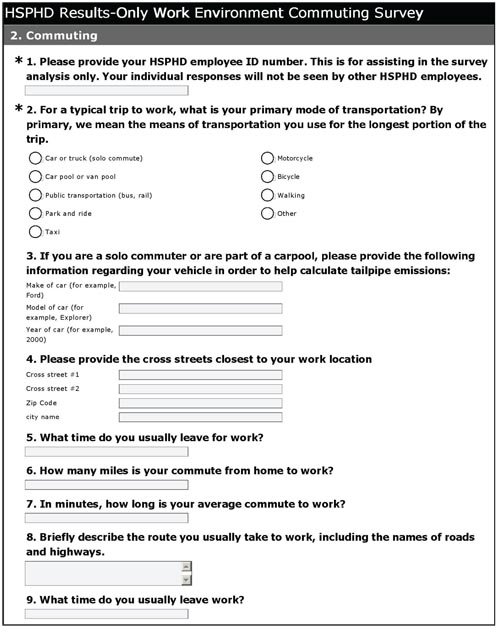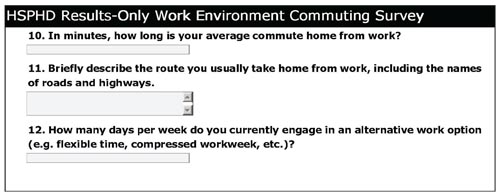2.0 TELECOMMUTER SURVEYS2.1 Purpose and ApproachThe Minnesota UPA telecommuting project is being conducted by the Hubert H. Humphrey Institute of Public Affairs at the University of Minnesota, with funding from the state of Minnesota. As noted in the telecommuting test plan, the Minnesota UPA telecommuting program encompasses the Minneapolis-St. Paul metropolitan area, whereas the national evaluation is interested only in the impact of the telecommuting program on traffic congestion on I-35W. The Institute has contracted with a consulting team that includes expertise in market research, branding and promotion, outreach, and survey research to assist with developing and implementing the project. The project includes an evaluation component. Surveys of telecommuters and employers participating in the telecommuting program represent important elements of the evaluation. The Minnesota UPA national evaluation team will utilize the survey results in the telecommuting analysis and other analyses. Members of the Battelle team are working with researchers from the Humphrey Institute to coordinate the use of the survey results in the national UPA evaluation. The UPA Telecommuting Program for the Twin Cities and the Telework Initiative Implementation Plan reports prepared by the Humphrey Institute, present the telecommuting program elements, including a discussion of the surveys of participating employers and employees. The outlines of the surveys include a variety of questions addressing employer and employee satisfaction and comfort with the different telecommuting options. The surveys also contain questions on commute travel behavior of benefit to the national evaluation in assessing the impact of the telecommuting program on traffic congestion on I-35W. An on-line evaluation webpage, known as the eWorkPlace Commute Tool, is being implemented to track data on the program participants. Another on-line tool, SurveyMonkey, is being used on an interim basis with participating employers and employees until the eWorkPlace Commute Tool is available. As outlined in the Telework Initiative Implementation Plan, participating employees will complete on-line surveys at three intervals over a nine-month period. The following schedule is outlined in the implementation plan for these surveys.
It is also anticipated that surveys and interviews will be conducted with employers participating in the program. These surveys and interviews will obtain information on the employer's perspective of the telecommuting program, including potential transportation impacts. 2.2 Survey QuestionnairesResearchers from the Humphrey Institute have provided the national evaluation team with a copy of the initial SurveyMonkey questionnaire being used with the Human Services and Public Health Department (HSPHD) ROWE participants. The survey, which takes approximately 30 minutes to complete, is being used to help identify possible ROWE participants. The survey includes questions on current commuting patterns, attitudes about ROWE, demographic information, and a one-day travel diary. The commute-related questions are presented Figure 2-1. 2.3 Analysis MethodsThe Humphrey Institute will be evaluating the entire telecommuting program for the metropolitan area, including assessing employer productivity, employer costs, and other factors. The national evaluation team will focus on the transportation impacts on I-35W from employees participating in the telecommuting, ROWE, and flexible work arrangements program. The national evaluation is interested in trips removed from I-35W. Questions 8 and 11 in the survey in Table 4-1 addresses the routes, including the names of roads and highways, the individual usually takes to and from work. This information will be used to identify telecommuters normally traveling on I-35W to include in the Minnesota UPA national evaluation. Examples of the analysis that will be conducted by the national evaluation team using the survey results are highlighted below.

Figure 2-1. HSPD ROWE Commuting Survey 
Figure 2-1. HSPD ROWE Commuting Survey (Continued) As previously discussed, the Humphrey Institute is conducting this survey as a panel survey, with the same respondents providing responses to survey questions at enrollment, three months post enrollment, and nine months post-enrollment. As with any panel survey, it is important that the statistical analysis account for the nature of the survey, particularly recognizing that each respondent (“subject”), serves as their own control. The national evaluation team will utilize longitudinal models that explicitly account for the “within person” variability through the use of mixed models. These general linear models (GLMs) will follow the general form indicated in Equation 1. Equation 1. Responseij = μ + ß1 * Timei + ... + Respondentj + ∈ij where: ß1 is the estimated linear trend in the response across the three survey time periods; Respondentj is a random effect estimating the “within person” variability and accounts for the fact that multiple responses are measured from the same survey participant; and, ∈ij is the explained variation in the model (or in the case where the response is being modeled as a mixed-model logistic regression model, this term does not exist). Within the context of this modeling framework, we will use model-based estimates to conduct hypothesis testing and to estimate average values for different combinations of explanatory factors. In particular, statistical tests performed on the ß1 will provide a convenient method for testing to determine if there is a statistically significant linear trend over time in the response. Interaction terms with this effect will be used to examine if this linear trend differs for different response groups. Table 2-1 summarizes the anticipated statistical power and/or precision of sample estimates for each of the data elements and measures of effectiveness presented in Table 2-1. In developing these estimates, we have assumed that 500 of the anticipated 1,700 survey participants will complete the survey for all three waves and that the modeling framework described above will be used as the statistical methodology. Other necessary assumptions are presented in the table. Based upon historical levels of key performance measures2, there should be sufficient statistical power to detect meaningful levels of differences (provided they exist) in the key national evaluation measures. In particular, we anticipate the following:
2.4 Schedule and ResponsibilitiesThe schedule for the telecommuting surveys is dependent on employers and employees agreeing to participate in the telecommuting program. The recruitment of employers has been initiated and surveys of employees at one company have been undertaken. The recruitment of participating employers and employees will continue until March, 2010. The national evaluation team will monitor the status of participation in the telecommuting program and will work with researchers from the Humphrey Institute on various aspects of the evaluation. The responsibilities for the surveys of employers and employees participating in the Minnesota UPA telecommuting program include:
2 State Demographics Profiles, U.S. Census, April 2003 OSD-03-104 "Reasons for Recent Large Increases in Commute Durations," University of Minnesota, Hubert H. Humphrey Institute of Public Affairs 301 19th Ave. S. Minneapolis, MN 55455 http://www.lrrb.org/PDF/200702.pdf You may need the Adobe Acrobat Reader to view the PDFs on this page. | ||||||||||||||||||||||||||||||||||||
| US DOT Home | FHWA Home | Operations Home | Privacy Policy | ||